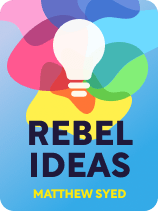

This article is an excerpt from the Shortform book guide to "Rebel Ideas" by Matthew Syed. Shortform has the world's best summaries and analyses of books you should be reading.
Like this article? Sign up for a free trial here.
Want an overview of Matthew Syed’s Rebel Ideas book? What are cognitively diverse groups?
Matthew Syed wrote Rebel Ideas to explain why he believes diverse groups are higher-performing than homogeneous groups. The book provides actionable advice for creating cognitively diverse groups and avoiding the dangers of homogeneity.
Read on for an overview of Matthew Syed’s book Rebel Ideas: The Power of Diverse Thinking.
Rebel Ideas Book Overview
Many people think of diversity in the context of social justice. For instance, we might think that diversity is a prerequisite to equal participation in areas such as higher education, politics, and the workplace. But Matthew Syed takes a different approach, exploring how diversity boosts group performance and intelligence. In particular, he argues that we should foster diversity because diverse groups are more collectively intelligent than homogeneous ones. In his 2019 book, Rebel Ideas, Matthew Syed explains why cognitively diverse groups—those whose members have various different thought processes and perspectives—are superior to homogeneous ones.
Cognitively diverse groups, he argues, can harness the diverse experiences of their members, leading to increased performance and innovative ideas. Homogeneous groups, by contrast, often suffer from collective blindness, as members simply reinforce each other’s views rather than challenge them. Consequently, Syed concludes that diversity is crucial for group success.
As the founder of Matthew Syed Consulting, which helps companies reap the benefits of cognitive diversity, Syed brings years of experience cultivating diversity in the workplace into his discussion about the importance of diverse groups in Rebel Ideas. He offers examples demonstrating the tangible value of cognitive diversity in group settings.
Introduction to Diversity Science
To begin, we’ll discuss the key concepts that underlie the arguments in Matthew Syed’s Rebel Ideas. In particular, we’ll examine how cognitively diverse groups have a better grasp of the problem space, and therefore are more collectively intelligent than homogeneous groups.
Defining the Problem Space
According to Matthew Syed’s Rebel Ideas, the notion of a problem space is central to diversity science. Put simply, the problem space encompasses every idea and perspective relevant to the problem you want to solve.
For example, imagine you wanted to build a computer from scratch. In that case, your problem space would include knowledge of coding, battery science, computer hardware, and so on.
Syed explains that for solving simple problems, an individual can grasp all of the problem space’s ideas. If you need to tie your shoes, for instance, you probably have all the information within that problem space.
However, for more involved problems, no single person can know all the information in the problem space. For example, nobody knows all of the information necessary to construct a rocket ship—such problems require teams with diverse bodies of knowledge.
Consequently, Syed infers that homogeneous groups of intelligent individuals can’t solve complex problems by themselves. After all, such groups don’t span the entire problem space. For instance, a team of genius coders with no other knowledge won’t be able to build an entire computer, since they lack the scope of information needed to build computers.
How Cognitive Diversity Leads to Collective Intelligence
According to Matthew Syed’s Rebel Ideas, groups that more fully cover the problem space are more collectively intelligent—in other words, they’re better versed to understand and solve difficult problems. For this reason, Syed argues that cognitive diversity—the range of insights, ideas, and viewpoints represented in a group—is the main factor that determines collective intelligence.
Syed concedes that groups of more-intelligent members will be more collectively intelligent, all else being equal. However, if these members all share the same ideas and perspectives, they’ll suffer from knowledge clustering: Their knowledge will overlap substantially, creating a group that’s scarcely more intelligent than any individual member.
Therefore, Syed concludes that we can’t determine collective intelligence by adding up each member’s knowledge, as that would overvalue homogeneous groups. Rather, he argues that collective intelligence depends on the differences in what group members know. For this reason, groups that are cognitively diverse have greater collective intelligence.
The Dangers of Homogeneity
Using these insights from diversity science, Matthew Syed’s Rebel Ideas examines the dangers posed by homogeneity. In this section, we’ll discuss three phenomena: homophily, echo chambers, and standardization.
- Homophily: Syed’s first danger is homophily—our tendency to surround ourselves with similar, like-minded people. According to Syed, homophily leads to collective blindness because it creates groups that only know small portions of the problem space.
- Echo Chambers: In addition to homophily, Syed argues that homogeneous groups are susceptible to forming echo chambers. Put simply, echo chambers filter out alternate views and undermine the group’s trust in those with different perspectives. Consequently, echo chambers support the development of increasingly extreme views.
- Standardization: Finally, Syed discusses the dangers of homogeneity in the context of standardization—the practice of designing systems to fit “average” individuals rather than tailoring systems to individual differences. Syed argues that standardization forces us to conform to uniform molds, creating systems that are less effective.
The Advantages of Cognitive Diversity
Alongside the harms of homogeneity, Matthew Syed’s Rebel Ideas discusses the specific benefits of cognitively diverse groups. In this section, we’ll discuss two such benefits: the wisdom of crowds, and greater capacity for innovation.
How Cognitive Diversity Harnesses the Wisdom of Crowds
According to Syed, cognitively diverse groups benefit from the wisdom of crowds: They become more collectively intelligent as their diverse perspectives create greater collective knowledge.
To illustrate, Syed cites Jack Soll’s study examining the accuracy of 28,000 economic forecasts. This study, Syed relates, found that top economists are about 5% more accurate than average economists.
However, the study also averaged the top six economists’ predictions, as if they were members of a single team. These results, Syed notes, were impressive: The average prediction of the top six economists was 15% more accurate than that of the top individual economist.
(Shortform note: In The Wisdom of Crowds, James Surowiecki discusses various other cases in which averaging group members’ estimates yields more accurate predictions than those of the best individuals. For example, he tells the story of Francis Galton, a British scientist who visited a fair where 800 people guessed the weight of an ox; the average prediction was 1,197 pounds, while the ox itself weighed 1,198 pounds. According to Surowiecki, this represents a broader trend: The aggregate judgment of non-experts is often more accurate than individual judgments of experts.)
Communication Within Diverse Groups
Finally, Matthew Syed’s Rebel Ideas discusses how the communication structure of a group can either undermine or enhance the value of cognitive diversity.
How Dominance Hierarchies Negate Cognitive Diversity
According to Syed, dominance hierarchies in which leaders rule via fear and threats are a common feature of human societies. He argues that these hierarchies suppress views that differ from the leaders’, thus reducing the collective intelligence of cognitively diverse groups.
Syed says dominance hierarchies played an important evolutionary role, as groups with dominant leaders were more likely to survive. Because prehistoric societies were typically faced with simple decisions, having a dominant leader make decisions was effective and more efficient. By contrast, groups that squabbled over straightforward decisions were less efficient and thus less likely to survive.
(Shortform note: Beyond bolstering group survival rates, researchers argue that dominance hierarchies led directly to humans’ greater cognitive capacities. Participating in a dominance hierarchy required us to distinguish between different ranks, understand the behaviors permitted for our own rank, and decide whether to change our rank. So, the individuals who succeeded in dominance hierarchies possessed the cognitive capacity needed to make these judgments, which they then passed on to future generations.)
How Prestige Hierarchies Harness Cognitive Diversity
As an alternative to dominance hierarchies, Syed examines prestige hierarchies, whose leaders are followed freely out of respect, rather than fear. According to Syed, leaders of prestige hierarchies listen carefully to diverse perspectives, maximizing collective intelligence.
(Shortform note: In a similar vein, experts also argue that groups need psychological safety—an environment where members don’t fear embarrassment or punishment for offering “wrong” ideas—to maximize collective intelligence and success. In such groups, members don’t blame each other for mistakes, but view mistakes with curiosity and an open mind. Therefore, psychologically safe groups actually benefit from discussing flawed ideas, as they learn from them.)
Syed argues that, from an evolutionary perspective, prestigious leaders who shared their knowledge created groups where generosity was prized. Consequently, leaders themselves benefited from the open flow of information. And because prestigious leaders share their knowledge, multiple prestigious leaders could exist peacefully within a group.

———End of Preview———
Like what you just read? Read the rest of the world's best book summary and analysis of Matthew Syed's "Rebel Ideas" at Shortform.
Here's what you'll find in our full Rebel Ideas summary:
- Why diverse groups are more collectively intelligent than homogeneous ones
- Actionable advice for creating cognitively diverse groups
- Why systems shouldn't be designed to fit the "average" person






